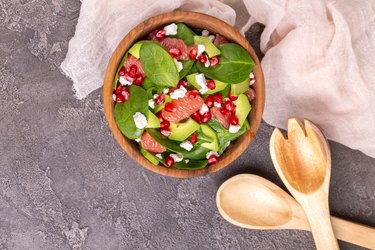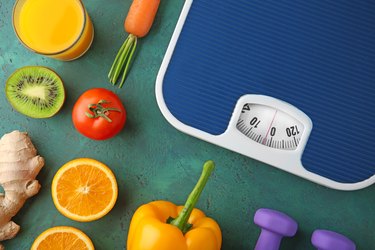
Over the years, Weight Watchers — now called WW — has revised their weight-loss and wellness program. This includes their "points" system, which provides people with a point-based guideline for how much and what kinds of food to eat. But how many calories is a Weight Watchers point, exactly?
Here, we explain the Points system and whether it's possible to convert WW points to calories.
Video of the Day
Video of the Day
What Are PersonalPoints?
WW recently replaced its SmartPoints system with the PersonalPoints Program, which provides you with a customized daily points budget and ZeroPoint food list (that is, foods that don't count toward your daily points allowance), according to the website. This Points system is more flexible, as eating nutritious foods, drinking water and exercising allow you to add to your budget.
Your points per day will vary based on your lifestyle and health needs, per the website. For instance, if you're tall and highly active, you may have a larger PersonalPoints budget than someone shorter and more sedentary.
You can learn your PersonalPoints allowance by signing up for WW, downloading the app and answering some questions about your age, height, weight, sex, activity level, underlying health concerns and weight-loss goals. From there, the app will calculate your points allowance.
The price of WW depends on which plan you pick (and can vary based on location). Here are the subscription options:
- Digital: Starts at around $3.53 per week
- Unlimited Workshops + Digital: Starts at around $6.92 per week
The program also charges a $20 starter fee, but this is frequently waived through promotions.
Tip
Before trying WW, talk to your doctor or registered dietitian to determine if it's the best weight-loss diet for you.
Trying to Calculate PersonalPoints to Calories? It’s Not a 1-to-1 Conversion
If you're planning on converting Weight Watcher points to calories, it may not be as straightforward as you think.
While in the past it was possible to calculate how many calories was in a Weight Watchers point, the new PersonalPoints system works differently — it determines a food's points based on overall nutrition, rather than individual factors like calories.
Foods packed with beneficial nutrients may thus contain fewer points than less nutrient-dense snacks, even if the calorie content of the first food is higher. For instance, a 300-calorie grilled chicken breast will have fewer points than a 300-calorie brownie because it contains more nutrients, according to the website.
As a result, there's no way to correlate calories to points — how many calories is in 30 Weight Watchers points, say, will vary based on the nutritional content of your food choices for the day.
Luckily, though, you don't have to calculate how many calories is in a Weight Watchers point. WW offers an app for both Apple/iOS devices and Google/Android devices that contains a food database. Rather than trying to calculate points yourself, you can scan a product's barcode or search the database to quickly determine the food's PersonalPoints value.
Zero-Point Foods

The PersonalPoints Program also provides you with a customized ZeroPoint list of foods that don't count toward your daily points allowance.
Like your points budget, your zero-point foods will vary based on your unique lifestyle and health needs, per the website. Now, this doesn't mean the foods themselves contain zero calories — rather, your list will include nutritious foods that suit your goals.
In general, though, here's a list of nutritious foods to include if you're following a WW diet:
- Fibrous foods like fruit, vegetables, legumes and whole grains
- Lean proteins like fish, poultry, eggs, tofu and tempeh
- Beneficial fats like nuts, seeds and olive oil